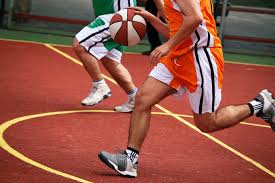Which shoe should I choose for Basketball? – by Andrew Midolo
 Footwear is an important part of any sport when looking at prevention of injuries, rehabilitating from injury and improving comfort when playing and training. There are so many different shoes and brands and it can sometimes be a daunting prospect to pick the right shoe for your chosen sport. Basketball is one of these sports with many different design aspect to look out for to help with comfort and injury prevention. Due to basketball being a high impact sport there are quite a few common injuries such as; lateral ankle sprains and overuse injuries, that the shoe aid in preventing.
Footwear is an important part of any sport when looking at prevention of injuries, rehabilitating from injury and improving comfort when playing and training. There are so many different shoes and brands and it can sometimes be a daunting prospect to pick the right shoe for your chosen sport. Basketball is one of these sports with many different design aspect to look out for to help with comfort and injury prevention. Due to basketball being a high impact sport there are quite a few common injuries such as; lateral ankle sprains and overuse injuries, that the shoe aid in preventing.
I will be discussing these aspects in detail to help anyone going into a new season and looking for new basketball shoes.
Before deciding on what shoes to buy, you firstly need to fit the shoe to your position:
- Guards: speed and agility type movements – cutting movements from side-to-side, sprinting and sudden stopping
- Centres: jumping and strength
- Forwards: an all round player requiring speed and agility with strength and jumping
Thickness of the sole:
In basketball shoes one of the main points of difference from runners is the fact that they are flatter and lower to the ground. This key difference helps with traction and stability – the lower the shoe is to the ground the less likely the foot and ankle is going to roll.
- So for people with a history of lateral ankle sprains a thinner, flatter sole can help in the prevention of further injury.
- For people with a history of heel pain, calf or hamstring injury/tightness may find that a flatter thinner sole can place increased tension and pressure on these area and may lead to further injury. So looking for a shoe with a slightly elevated heel can help offset this issue.
High cut, mid cut and low cut:
This feature has been widely researched and there is no evidence to suggest that a higher cut shoe helps in the prevention of ankle sprains. It is down to personal preference and comfort whether you go for a higher cut shoe or lower cut. If a higher cut shoe makes you feel more stable then by all means select that option.
- For players who require speed and agility, like a guard, a lower cut shoe may be preferable due to there being a significant reduction in the weight of the shoe compared with a higher cut shoe.
Sole of the shoe:
The sole of basketball shoes are usually rubber to help with grip on the basketball court. The rubber sole can also come up around the edges of the shoe; this helps with stabilising the foot in the shoe and increases the surface area of the sole to help when changing directions.
Again due to the high impact of stopping and starting, shoes must be able to prevent any abnormal movements through the midfoot. So a stiff soled shoe is important; shoes should only be able to bend through the sole of the shoe and not through the arch and rearfoot and you should not be able to twist the shoe excessively.
Adequate cushioning:
Due to the high impact nature of basketball on the feet through the movements as well as the hard court, adequate cushioning is required for comfort and shock absorption. This comes in many forms depending on the different brand; but is usually a type of foam(EVA).
- For centres who are doing allot of jumping and landing, it is especially important for adequate cushioning for shock absorption and over use injuries
If you wish to discuss your footwear choices conducive to your individual foot type, please don’t hesitate to contact our clinics on 9870 1301 or 9887 2233